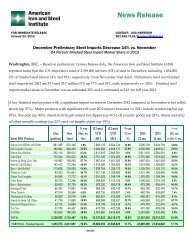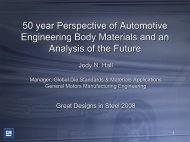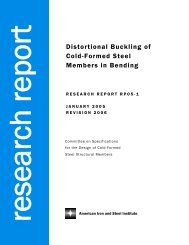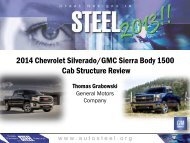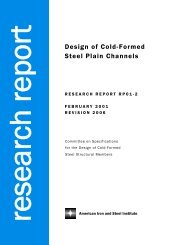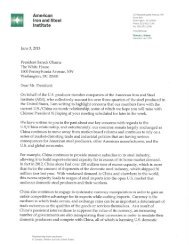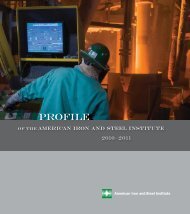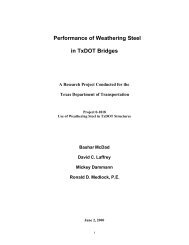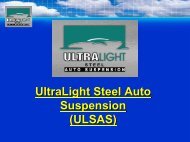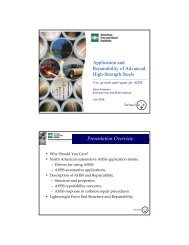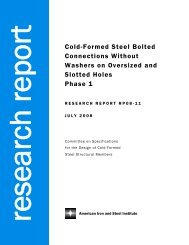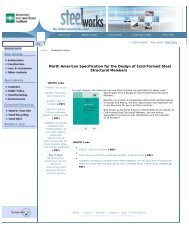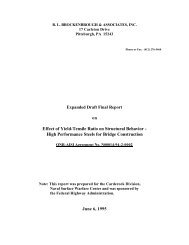Environmental Life Cycle Assessment of Southern Yellow Pine ...
Environmental Life Cycle Assessment of Southern Yellow Pine ...
Environmental Life Cycle Assessment of Southern Yellow Pine ...
You also want an ePaper? Increase the reach of your titles
YUMPU automatically turns print PDFs into web optimized ePapers that Google loves.
EXECUTIVE SUMMARY<br />
Indicator results in Table 1 show that a significant volume <strong>of</strong> untreated hazardous waste is generated <br />
in the BAU scenario – over 590,000 tons over the 40-‐year time horizon. The difference between the <br />
BAU and SPR scenarios is enough hazardous waste to completely fill nearly 300 Olympic-‐size <br />
swimming pools. <br />
1.6 Discussion <strong>of</strong> the <strong>Environmental</strong> Advantages <strong>of</strong> the BAU Scenario <br />
1.6.1 Lower Land Use Ecological Impacts in the Mesabi and Marquette Iron Ranges <br />
As shown in Table 1, the BAU and SPR scenarios impact different regions with different biomes and <br />
species affected. The BAU scenario does not impact three terrestrial species and one biome in the <br />
Mesabi and Marquette Iron Ranges. These lowered impacts include disturbance to Western Great <br />
Lakes forests, and the habitat <strong>of</strong> the Kirtland’s warbler, Wood turtle, and Blanding’s turtle.. <br />
1.6.2 Lower Emissions Affecting Regional Acidification <br />
The BAU scenario category indicator results are lower for Regional Acidification. The emissions in the <br />
SPR scenario classified in this impact category are dominated by those resulting from steel <br />
production, hot-‐dipped galvanization, and zinc smelting; most <strong>of</strong> these emissions are occurring in the <br />
Midwestern United States and Great Lakes region. These regions have sensitive soils, and a large <br />
fraction <strong>of</strong> acidifying emissions from steel production in this region deposit in sensitive areas, and can <br />
lead to acidification. In the BAU scenario, most emissions result from the electricity generation used <br />
in the production <strong>of</strong> the CCA treatment chemical. Though also occurring in relatively sensitive <br />
regions, the level <strong>of</strong> acidifying emissions in the BAU scenario is less, leading to a smaller indicator <br />
result. <br />
1.6.3. Lower Emissions Leading to Ground Level Ozone and PM 2.5 Exposure Risks <br />
The BAU scenario results in fewer risks <strong>of</strong> the exposure to humans from both ground level ozone and <br />
fine particulate matter (PM2.5). In the SPR scenario, the production <strong>of</strong> steel is the largest contributor <br />
to results for both <strong>of</strong> the impact categories <strong>of</strong> Ground Level Ozone Exposure Risks and PM 2.5 <br />
Exposure Risks. In the SPR scenario, the unit processes associated with steel production are <br />
concentrated in the United States Midwest and Great Lakes regions, both <strong>of</strong> which have relatively <br />
high population densities. This results in larger exposure risks from the emissions classified in these <br />
impact categories. In the BAU scenario, most emissions result from the production <strong>of</strong> the precursors <br />
going into CCA production, and the installation <strong>of</strong> wood utility poles. Though also occurring in <br />
relatively densely populated regions, the level <strong>of</strong> emissions in the BAU scenario is less, leading to a <br />
smaller indicator result. <br />
1.6.4. Zinc Resource Depletion <br />
The depletion <strong>of</strong> zinc resources is a clear advantage <strong>of</strong> the BAU scenario. For galvanized steel utility <br />
poles, zinc provides a sacrificial coating and very little zinc is recovered at end-‐<strong>of</strong>-‐life. <br />
April 2013 | ©SCS Global Services <br />
ES-‐ 21



